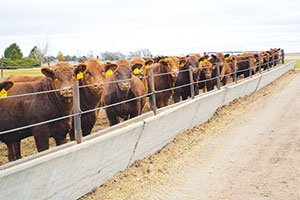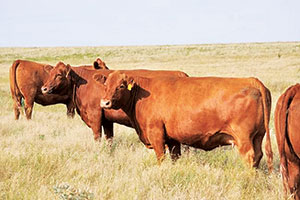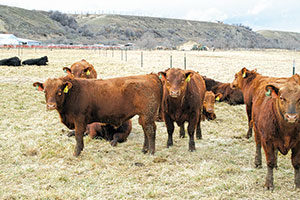Using the multi-breed genetic evaluation (MBGE) model first developed by Simmental in the 1980s, the two breeds accumulated a dataset that initially included over 9 million animal records.
Doing so helped establish those breeds as key players in the seedstock industry’s pursuit of crossbreeding in commercial livestock.
For producers seeking the power of heterosis in their herds, the combined herd book for Simmental and Red Angus has become an influential tool.
 Simmental breeds were promoted for stayability and the feedyard profit factors (yield grade, quality grade and carcass weight).
Simmental breeds were promoted for stayability and the feedyard profit factors (yield grade, quality grade and carcass weight).
Red Angus animals highlighted calving ease, heifer pregnancy, stayability and maintenance energy EPDs.
The successful collaboration is now expanding.
Last summer, Simmental and Red Angus also began publishing EPDs on the same base to be compared across breeds.
This strategy breaks decades of convention, where breeds presented their own separate EPDs according to their base references and languages.
A base provides unchanging reference points for future generations of the breed. Breeders can thereby use the base to identify genetic trends when certain traits shift from the base.
“It’s kind of been a dream come true for our two breed programs,” said Lynn Pelton, a producer of Red Angus, SimAngus and Simmental seedstock in Burdett, Kansas.
“Our past sale catalogues have had two sets of EPDs representing each breed. Our customers now have the capability of comparing the two breeds from the same base, which will be beneficial in making good management decisions in their own operations.”
 Additionally, the MBGE database that Simmental and Red Angus created two years ago is also growing.
Additionally, the MBGE database that Simmental and Red Angus created two years ago is also growing.
By the spring of 2013, a new run of EPDs in the shared database will cover RAAA, Canadian Angus Association, Simmental, Maine-Anjou, Chianina, along with the American Gelbvieh Association, for a total database that will exceed 11 million animals.
“Together we have built this technology and this system, that can run all these breeds together in the most accurate manner that science has ever known,” said Jerry Lipsey, executive vice president for the ASA.
“The multi-breed genetic evaluation system that combines all the breeds, is right at the cutting edge of science.”
“What they’re doing is sound,” said Jack Whittier, professor of animal science at Colorado State University. “It’s based on the same basic principles that any EPD calculation is.
The joining of those databases will be a better predictor of heterosis response to animals of multiple breeds compared to the adjustments we’ve done in the past.”
Wade Shafer, director of performance programs for ASA, says the shared EPD listing may require more time and familiarity for Simmental and Red Angus producers.
Once they grow accustomed to the new base, however, producers will be able to directly compare genetic predictions on the largest multi-breed database in the industry.
New genetic strategies
For Simmental officials, building a multi-breed cooperative effort was rooted in its own history. In the late ‘60s, the ASA worked with other breeds to expand germplasm diversity in North American beef herds.
After years of expanding those genetic lines, Simmental officials sought ways to utilize its accumulation of data on progeny. Cornell University emerged as the research partner capable of providing improved EPD calculations using Simmental records.
Then in 1997, the university added a new dimension with multi-breed genetic evaluations. By honing these MBGEs, Cornell and Simmental now had a way to accurately compare crossbred seedstock for genetic merit.
“We on the Simmental side used it for our own database,” said Lipsey. “We only envisioned we would use it for members of ASA.”
But when other associations such as Maine-Anjou and Chianina sought an agreement to have their EPDs joined with Simmental for improved genetic evaluations, they learned that the appeal went across the industry.
“Red Angus said to us, ‘would you consider a business partnership, to share the EPDs, and together to fund the science, fund the personnel and new technology?
Together we could go forward the strongest and most powerful multi-breed genetic evaluation system in the world.’”
Lipsey said there are several benefits in the collaborative efforts shared by ASA and RAAA, but key among them for their members is crossbreeding accuracy.
“Multi-breeding genetic evaluations allow Simmental producers who have purebred, perfectly lined genetic traits. But they also deliver heterosis, because they complement and enhance traits that are all vital in beef production.
New lines and new breeds are developed, and it opens the scientific doors to innovative seedstock producers more than they ever have.”
Growth for Red Angus
Genetic innovation has likewise been a key strategy for Red Angus. RAAA supported crossbreeding by allowing Red Angus-influenced cattle to be registered since its founding in the ‘50s.
In 1979, a formalized category system was established for the registration of percentage cattle. That led to an agreement in 2001-02 with the Canadian Angus Association (CAA) where CAA data (red and black) was pooled with RAAA data and RAAA-calculated EPDs for CAA.
The strategy rapidly built Red Angus numbers nationwide. Chief Executive Officer Greg Comstock said Red Angus registrations in 2011 ranked fourth nationally with 46,094, which represents a 300 percent increase since 1990, when Red Angus ranked 15th.
“Being an English breed with open herd book, that makes Red Angus unique,” said Comstock. “We have a growing number of members who are producing hybrid and/or composite bulls.
Thus, it’s important that we are able to supply commercial customers with the most reliable information to assist in their selection of those bulls in structured crossbreeding programs.”
The common base for EPDs is all about accuracy and making selections simpler for customers.
“One of the great things we gained as a breed when we first did multi-breed evaluations were tremendous gains in accuracy because of strength of over 11 million-head database,” Comstock said. “So many common animals between us just adds to the accuracy of our own predictions.”
The other key advantage, Comstock said, was in sharing resources and incorporating new technologies. “Two heads are better than one,” he said. “Rather than having us work on a project and Simmental work on a project, there’s a shared success in working together.”
The two breeds now build their cooperative ideas through a joint Technical Advancement Committee, with a mix of industry, academia and breeder leadership from both associations.
By sharing those resources and personnel, producers appreciate the connections that help all of their associates prosper.
“I think the Simmental and Angus cattle have a leading role in the industry as far as crossbreeding EPDs are concerned,” said Pelton. “Having these tools together helps us utilize the genetics more than ever.” ![]()
PHOTOS
TOP RIGHT: Mutli-breed genetic evaluations have enhanced trait analysis for today’s Red Angus bulls. Photo courtesy of Progressive Cattleman staff.
BOTTOM TWO RIGHT: Shared data between Simmental and Red Angus breeds have provided simplicity and accuracy to Lynn Pelton’s Red Angus, SimAngus and Simmental lines. Photos courtesy of Lynn Pelton.







